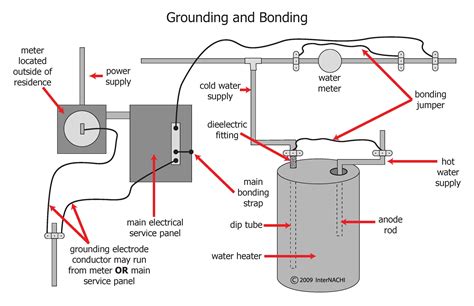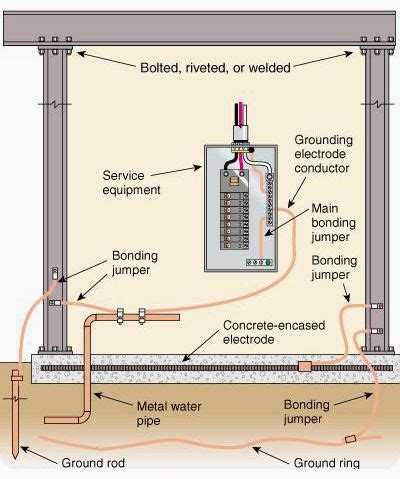electrical panel box grounding with neutral Nearly every application can apply Environmental Potentials waveform . This article dives into the essential techniques and precautions for Z and N bending in sheet metal fabrication. You’ll learn about critical procedures, positioning principles, and special processing methods to ensure accurate and .
0 · residential electrical service grounding
1 · residential electrical grounding and bonding
2 · residential electric service grounding detail
3 · proper grounding of electrical panel
4 · grounding rod size chart
5 · grounding requirements for residential homes
6 · grounding a main electrical panel
7 · electrical panel grounding diagram
$7.99
Neutral is the return path of the current, and ground wire holds the fault current to trip the breaker in protecting the person and the facility. The neutral and ground should never be bonded .Contact us at 1-844-500-7436 or [email protected] for any questions you .
Environmental Potentials is proud to offer a complete line of products to meet the .

Nearly every application can apply Environmental Potentials waveform .NEC 2008 states that the neutral and ground wires should be “bonded” .
LIBRARY Complete Product ListCATALOG Catalog 2022 – Email purposes only .Environmental Potentials’ patented waveform correction technology was .
residential electrical service grounding
If you bond neutral and ground together in a sub panel, it's more or less the same as creating a bootleg ground in a branch circuit, except that it involves a lot more amperage. In the event of a neutral failure in the sub panel or between the .

As long as this is a Main service entrance, you can connect grounding (ground) and grounded (neutral) conductors to either bus bar. As long as: The .On my electric panel the Neutral is tied to the ground. The ground is a bare copper wire run back to my water main. a. Electricity chooses the path of least .
Beginning with the 2008 National Electrical Code, residential subpanels are required to be wired with a four-wire feed (two hots, a neutral, and a ground), and the grounds and neutrals must be isolated from one another.
Hot, Neutral and Ground Wiring— What’s The Difference? In both of these panel boxes, there are four types of wires: Two hot wires (black or red casing) One neutral wire (white casing), and One ground wire (green casing or .
residential electrical grounding and bonding
Answer: Yes, in the main electrical panel, the neutral and ground wires are tied (bonded) together at the main bonding jumper or bus bar. This connection creates a common reference point and helps establish a low-impedance path for fault .
Assuming this is a Service panel where neutral (grounded white) and grounding (bare or green) are all on the same bar, I see the following issues: Only one grounded wire per . An inadvertent ground fault could result if the ground wire and neutral are on the same bus bar on a sub-panel. This situation could energize any metal parts of the electrical system and circuits and deliver a potentially .
Neutral is the return path of the current, and ground wire holds the fault current to trip the breaker in protecting the person and the facility. The neutral and ground should never be bonded together in the facility except for the main panel.If you bond neutral and ground together in a sub panel, it's more or less the same as creating a bootleg ground in a branch circuit, except that it involves a lot more amperage. In the event of a neutral failure in the sub panel or between the panels, all of the return current travels on the ground, and energizes every grounded thing between .
As long as this is a Main service entrance, you can connect grounding (ground) and grounded (neutral) conductors to either bus bar. As long as: The grounded (neutral) bus bar is properly bonded. Only one grounded (neutral) conductor can be under a screw terminal.On my electric panel the Neutral is tied to the ground. The ground is a bare copper wire run back to my water main. a. Electricity chooses the path of least resistance. Is the current happier to go back to the power supply rather then ground which is right there in the house basement?
To summarize everything, we need to keep subpanel grounding and neutral isolated to maintain the correct flow of current from the subpanel to the main panel and prevent short circuits and ground faults from harming our electrical system and appliances.Beginning with the 2008 National Electrical Code, residential subpanels are required to be wired with a four-wire feed (two hots, a neutral, and a ground), and the grounds and neutrals must be isolated from one another. Hot, Neutral and Ground Wiring— What’s The Difference? In both of these panel boxes, there are four types of wires: Two hot wires (black or red casing) One neutral wire (white casing), and One ground wire (green casing or bare metal wire – usually copper or aluminum)Answer: Yes, in the main electrical panel, the neutral and ground wires are tied (bonded) together at the main bonding jumper or bus bar. This connection creates a common reference point and helps establish a low-impedance path for fault currents.
residential electric service grounding detail
Assuming this is a Service panel where neutral (grounded white) and grounding (bare or green) are all on the same bar, I see the following issues: Only one grounded wire per terminal is allowed in most cases in a panelboard (do not put the white and bare in . An inadvertent ground fault could result if the ground wire and neutral are on the same bus bar on a sub-panel. This situation could energize any metal parts of the electrical system and circuits and deliver a potentially serious shock.

Neutral is the return path of the current, and ground wire holds the fault current to trip the breaker in protecting the person and the facility. The neutral and ground should never be bonded together in the facility except for the main panel.If you bond neutral and ground together in a sub panel, it's more or less the same as creating a bootleg ground in a branch circuit, except that it involves a lot more amperage. In the event of a neutral failure in the sub panel or between the panels, all of the return current travels on the ground, and energizes every grounded thing between .As long as this is a Main service entrance, you can connect grounding (ground) and grounded (neutral) conductors to either bus bar. As long as: The grounded (neutral) bus bar is properly bonded. Only one grounded (neutral) conductor can be under a screw terminal.On my electric panel the Neutral is tied to the ground. The ground is a bare copper wire run back to my water main. a. Electricity chooses the path of least resistance. Is the current happier to go back to the power supply rather then ground which is right there in the house basement?
To summarize everything, we need to keep subpanel grounding and neutral isolated to maintain the correct flow of current from the subpanel to the main panel and prevent short circuits and ground faults from harming our electrical system and appliances.Beginning with the 2008 National Electrical Code, residential subpanels are required to be wired with a four-wire feed (two hots, a neutral, and a ground), and the grounds and neutrals must be isolated from one another. Hot, Neutral and Ground Wiring— What’s The Difference? In both of these panel boxes, there are four types of wires: Two hot wires (black or red casing) One neutral wire (white casing), and One ground wire (green casing or bare metal wire – usually copper or aluminum)Answer: Yes, in the main electrical panel, the neutral and ground wires are tied (bonded) together at the main bonding jumper or bus bar. This connection creates a common reference point and helps establish a low-impedance path for fault currents.
how to remove a lost key electrical box lock
Assuming this is a Service panel where neutral (grounded white) and grounding (bare or green) are all on the same bar, I see the following issues: Only one grounded wire per terminal is allowed in most cases in a panelboard (do not put the white and bare in .
how to program a cnc milling machine
Unistrut Z Brackets, also known as Z shape fittings, offer versatile mounting solutions in metal framing. These Z shaped brackets come in various sizes and multiple hole patterns to fit different structural needs, providing strong, .
electrical panel box grounding with neutral|grounding requirements for residential homes